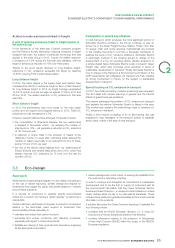APC 2012 Annual Report Download - page 70
Download and view the complete annual report
Please find page 70 of the 2012 APC annual report below. You can navigate through the pages in the report by either clicking on the pages listed below, or by using the keyword search tool below to find specific information within the annual report.
2012 REGISTRATION DOCUMENT SCHNEIDER ELECTRIC68
SUSTAINABLE DEVELOPMENT
2SCHNEIDER ELECTRIC’S COMMITMENT TO ENVIRONMENTAL PERFORMANCE
3.4 Eco-Production
Approach
Schneider Electric has rolled out the ISO14001 certifi cation for all
its manufacturing sites with more than 50people and large tertiary
sites. All these sites contribute to reporting, and therefore to the
Group targets. The certifi cation objective helps focus continuous
efforts to reduce the main environmental impacts of the sites,
shown in the table on pages 99-100 :
•energy consumption;
•CO2emissions;
•amount of waste produced;
•percentage of waste recovered;
•consumption of water;
•VOC emissions (Volatile Organic Compounds).
Action plans
ISO14001 certification of Group sites
As soon as the ISO14001 environmental management standard
was published in 1996, Schneider Electric decided to certify its
sites. For several years the Group has demanded that all industrial
and logistic sites with more than 50people be ISO14001 certifi ed
within two years of their acquisition or creation.
The extension of this internal directive to the major tertiary sites
was launched in2010. The headquarters of the Group in France,
in Rueil-Malmaison, was certifi ed in 2010. This extension was
reaffi rmed for the 2012-2014 period for all tertiary sites with more
than 500people.
At the Group level, the scope of certifi cation covers about 70% of
employees.
The challenge for the coming years is to maintain this performance
level by certifying all the new industrial sites within two years of their
acquisition or creation and to continue the new certifi cations of
large tertiary sites.
Management of industrial consumption
Water consumption
The Group provides a detailed breakdown of water consumption
that takes into account groundwater and water from the public
network. Water drawn for the sole purpose of cooling and
immediately released without alteration are also monitored and
are subject to separate accounting from2012, starting in2012 by
the sites Carros (Nice) and TEC38 (Grenoble) and all relevant sites
from2013.
Schneider Electric reports on the quantities of water consumed
by its sites on a six-monthly basis and monitors the per capita
consumption of water on a like-for-like basis in order to evaluate its
performance from one year to the next. From2013, this reporting
will be monthly.
In2012, the overall eco-production approach allowed the Group
to reduce its per capita consumption of water by 4.1% by the end
of 2012 in relation to2011 on a like-for-like basis. The target of
3.3% has been exceeded. Water used for cooling at the Carros
(Nice) and 38TEC (Grenoble) sites is not included in this calculation
for2012.
Water is not generally a critical resource in Schneider Electric’s
industrial processes.
Water is essentially used for sanitary purposes, sometimes for
cooling and in certain sites for surface treatment. In the latter case,
industrial water discharge is subject to treatment that is suitable
in terms of its pollutant potential and discharge into the natural
environment or in a plant subject to a monitoring plan.
As Schneider Electric industrial production is mainly based on
manual assembly processes or automatic processes for electrical
components and subsets, it has low water consumption and a
negligible impact on water quality.
Nevertheless, in2011 the Group initiated an analysis of industrial
site positions relative to water stress in different regions throughout
the world using the WBCSD tool (World Business Council for
Sustainable Development).
The “Everblue” project was launched in2012. This project aims to
better understand the uses of water within the Group, and therefore
its exposure to water-related risks, and to reduce consumption.
Particular attention is paid to the highest-consumption sites and
those located in areas of water stress, where the objectives of
reducing water consumption accompanied by specifi c action plans
are reviewed, site by site.
Energy consumption
See the Group’s energy consumption action plans on pages 63-64 .
Raw material consumption
Schneider Electric focuses on making its devices more compact
to conserve natural resources so that customers have more
environmentally friendly products to choose from. The Group
has developed design tools for managing thermal and electrical
constraints so that it can optimize the amount of materials required
in production. Each device’s Product Environmental Profi le
(PEP) lists the materials used. To facilitate end-of-life processing,
Schneider Electric chooses materials that are easy to recycle and
clip-together components that are easy to disassemble. Life cycle
analyses and recyclability assessments also help the Group identify
areas for improvement.
For more information on the Schneider Electric global action plan
relating to PEP and to end-of-life instructions, see the Green
Premium chapter on pages 65-67 . Also see the Green Plastic
program on page 67 .
Schneider Electric’s desire to reduce its environmental impact has
driven its focus towards the use of recycled raw materials. For
example, about 85% of cardboard used in Europe, 100% in Asia and
60% in North America comes from recycled material. With regard to
metals that Schneider Electric purchases on global markets, these
include recycled material from recovered waste. A UNEP (United
Nations Environment Program) report was published in 2011
addressing the situation with regard to metal recycling rates. On
a global level, 18metals have a recycling rate of over 50%, among
which are lead, gold, silver, aluminum, tin, nickel, zinc, copper and
























